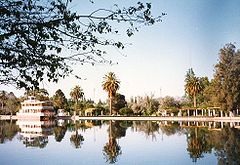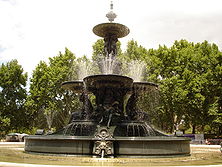
General San Martín Park
Encyclopedia

Mendoza, Argentina
Mendoza is the capital city of Mendoza Province, in Argentina. It is located in the northern-central part of the province, in a region of foothills and high plains, on the eastern side of the Andes. As of the , Mendoza's population was 110,993...
, Argentina
Argentina
Argentina , officially the Argentine Republic , is the second largest country in South America by land area, after Brazil. It is constituted as a federation of 23 provinces and an autonomous city, Buenos Aires...
.
Overview
The construction of the park, originally named Parque del Oeste (Western park), began on December 6, 1896, under the direction of the landscape architect Carlos ThaysCarlos Thays
Carlos Thays was a French-Argentine landscape architect, and a student of French landscape architect Édouard André.-Biography:...
, who employed a combination of English and French 19th century styles in its design. The gates at the main entrance were installed in 1909, and are decorated with a condor and the coat of arms of the city. The park was renamed in honor of General José de San Martín
José de San Martín
José Francisco de San Martín, known simply as Don José de San Martín , was an Argentine general and the prime leader of the southern part of South America's successful struggle for independence from Spain.Born in Yapeyú, Corrientes , he left his mother country at the...
, who led the Argentine War of Independence
Argentine War of Independence
The Argentine War of Independence was fought from 1810 to 1818 by Argentine patriotic forces under Manuel Belgrano, Juan José Castelli and José de San Martín against royalist forces loyal to the Spanish crown...
.
The 393 hectare (971 acre) park has 34 sculptures decorating the paths and roads. El rosedal (rose garden) is a promenade inaugurated in 1919. The park is also the location of the Estadio Malvinas Argentinas
Estadio Malvinas Argentinas
The Estadio Malvinas Argentinas is a stadium, in the city of Mendoza, Argentina, at General San Martín Park.It was built in 1976 in preparation for the 1978 World Cup...
; the Universidad Nacional de Cuyo; the Monument to the Army of the Andes
Army of the Andes
The Army of the Andes was a military force created by the United Provinces of the Río de la Plata and mustered by general José de San Martín in his campaign to free Chile from the Spanish Empire...
(created by Juan Manuel Ferrari and unveiled in 1914); The Frank Romero Day Amphitheater, site of the annual Fiesta Nacional de la Vendimia
Fiesta Nacional de la Vendimia
Fiesta Nacional de la Vendimia takes place annually in Mendoza Province, Argentina. It is one of the most important festivals in the country attracting large numbers of tourists to the region...
(National Grape Harvest Festival) since 1936; the Cornelio Moyano Museum of Anthropology and Natural Sciences, which maintains 40,000 exhibits; Gimnasia y Esgrima de Mendoza; the Andino Country Club; the Mendoza Lawn Tennis Club; El Pulgarcito Theater; a hippodrome
Hippodrome
A hippodrome was a Greek stadium for horse racing and chariot racing. The name is derived from the Greek words "hippos and "dromos"...
; a velodrome
Velodrome
A velodrome is an arena for track cycling. Modern velodromes feature steeply banked oval tracks, consisting of two 180-degree circular bends connected by two straights...
; a botanical garden
Botanical garden
A botanical garden The terms botanic and botanical, and garden or gardens are used more-or-less interchangeably, although the word botanic is generally reserved for the earlier, more traditional gardens. is a well-tended area displaying a wide range of plants labelled with their botanical names...
and zoo
Zoo
A zoological garden, zoological park, menagerie, or zoo is a facility in which animals are confined within enclosures, displayed to the public, and in which they may also be bred....
; and a large lake inaugurated in 1906, and site of the Club Mendoza de Regatas (established in 1909).
History

1861 Mendoza earthquake
The 1861 Mendoza earthquake was a major seismic movement in the province of Mendoza, Argentina. It took place on 20 March 1861, at 11:30 PM. It had a magnitude of 7.2 on the Surface wave magnitude scale and an intensity of IX in the Mercalli scale...
left the city affected by epidemics of diphtheria, cholera, and measles. These and other public health challenges figured prominently in the plans formulated for the city's reconstruction by the Minister of Works and Utilities, Emilio Civit. Civit drafted Provincial Law No. 3, which provided for a reforestation
Reforestation
Reforestation is the natural or intentional restocking of existing forests and woodlands that have been depleted, usually through deforestation....
program as part of a flood control
Flood control
In communications, flood control is a feature of many communication protocols designed to prevent overwhelming of a destination receiver. Such controls can be implemented either in software or in hardware, and will often request that the message be resent after the receiver has finished...
plan, as well as other improvements, such as a new prison. Following numerous delays, Law No. 19 was signed by Governor Juan Cornelio Moyano to that effect on December 6, 1896. The bill earmarked the creation of the Parque del Oeste, a "Western Park", and commissioned the noted French Argentine
French Argentine
A French Argentine is an Argentine citizen of full or partial French ancestry. French Argentines form the third or fourth largest ancestry group after Italian Argentines, Spanish Argentines, and perhaps German Argentines...
landscape architect Carlos Thays
Carlos Thays
Carlos Thays was a French-Argentine landscape architect, and a student of French landscape architect Édouard André.-Biography:...
for its design. Thays was responsible for other important Argentine parks such as Ninth of July Park
Ninth of July Park
Ninth of July Park is the largest public park in the city of San Miguel de Tucumán, Argentina.-History and overview:Economic growth in the Argentine Northwest city of Tucumán, as in cities nationwide, created the need for unprecedented urban improvements during the late nineteenth century...
, Sarmiento Park
Sarmiento Park
Sarmiento Park is the largest public park in Córdoba, Argentina.-Overview:The development of a suburb south of the rapidly growing Córdoba of the late nineteenth century created the need for an extensive new green space for the area. The new neighborhood's chief developer, Miguel Crisol,...
, Parque Tres de Febrero
Parque Tres de febrero
Parque Tres de Febrero, also known as the Bosques de Palermo , is a city park of 25 hectares located in the neighborhood of Palermo in Buenos Aires, Argentina...
, and Nahuel Huapi National Park
Nahuel Huapi National Park
Established in 1934, the Nahuel Huapi National Park is the oldest national park in Argentina. It surrounds Nahuel Huapi Lake in the foothills of the Patagonian Andes. The largest of the national parks in the region, it has an area of , or nearly 2 million acres...
.
Construction of this park sparked controversy among governing and opposition politicians in Mendoza. Governor Moyano stated that the project address public health weaknesses that persisted after the quake, while the opposition argued that this large-scale construction sought only elitist purposes, and that with a smaller amount of money major deficiencies of the day such as a lack of sewers, waterworks, and irrigation ditches
Acequia
An acequia or séquia is a community-operated waterway used in Spain and former Spanish colonies in the Americas for irrigation. Particularly in Spain, the Andes, northern Mexico, and the modern-day American Southwest, acequias are usually historically engineered canals that carry snow runoff or...
could be overcome. The park proved beneficial to the Greater Mendoza
Greater Mendoza
Gran Mendoza is the name given to the large urban conurbation around the city of Mendoza in Argentina. The 2001 Census estimated the population of Gran Mendoza as 848,660 making it the 4th largest urban conurbation in Argentina....
in the long term, however, resulting in significantly improved air quality in the area, and well as greater investment higher real estate values.
 |

